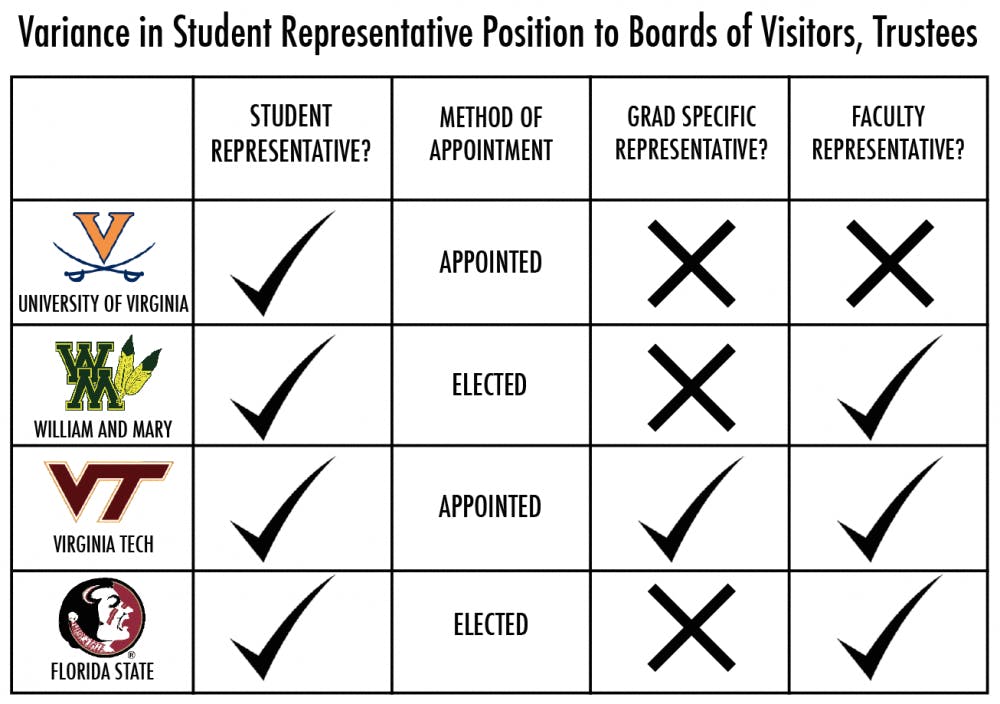Eighteen people sit on the University’s Board of Visitors. Only seventeen, however, have voting power on the Board and one — fourth-year College student Meg Gould — is there to help ensure the Board understands the breadth of the student experience when making decisions.
“You are essentially serving as a sounding board for a lot of these issues that affect students,” Gould said. “You should have an active voice in the conversation.”
The role of the student representative at the University is an informative one — and, unlike at some schools, he or she is strictly separated from the political role of his or her Student Council leader counterparts. For the University’s student representative, it is all about providing perspective.
Choosing the Representative
Though the student member is officially appointed by the Executive Committee of the Board, students perform much of the work in the selection process by making up a large part of the selection committee, which includes several elected student leaders in addition to University administrators.
“The selection committee has Pat Lampkin, the Secretary of the Board of Visitors, and then it has just a collection of student leaders,” Gould said. “UJC, Honor, Student Council, the Student Member of the Board the year before, a grad. school representative and then two other students that are kind of at-large representatives.”
Student leaders cut a large applicant pool down to two or three applicants — though there is no required target — who are then presented to the Board’s Executive Committee for final approval, according to former Board of Visitors Student Member Blake Blaze.
The Student Representative’s Role
Blaze, who sat on the Board during the 2013-14 academic year, emphasized his position as an important point of communication between the student body and the Board, adding that the position served a dual role.
“You are at once a member of the Board and also a student, and you are trying to reflect best the interests of the students to the Board as well as the decisions of the Board to students,” Blaze said.
The student member, however, is not meant to perfectly represent the actual opinions of the student body. Instead, the member acts as a window into the student experience.
“We do not expect the student to speak on behalf of the student body,” Board Rector George Martin said in an email. “Rather we want the perspective of someone who is a student. Obviously to the extent the student member has received helpful information from students or student groups, it is appropriate to share those positions and/or opinions with the full board or a committee of the board.”
The student member is not the only point of contact, however. The Board also interacts directly with student groups and individuals on Grounds in order to assess student needs, Martin said.
Nevertheless, the student member position is the most direct and consistent link between the student body and the Board. Recent members have worked to redefine the position so as to give the Board a more accurate image of the student population.
“In years past it’s been more of a passive role, but I think in the past couple of years student members [have been] much more active in committee meetings,” Blaze said.
According to both Blaze and Gould, student members have begun presenting brief reports in recent years on student life and priorities at the beginning of all full Board meetings in an effort to keep the visitors in touch.
These reports consist of general events on Grounds and strong currents apparent in student opinion.
Significant preparation goes into how student members source such information, Gould said, and — because her term has just begun — she said the process is ongoing.
Student Advocacy to the Board
Just because there is a student member of the Board does not mean he or she participates in all of the Board’s functions. Student members of the Board are afforded no voting rights, which in turn affects how he or she approaches specific student concerns.
“You’re not going to advocate for any particular cause because you don’t have a vote to back it up with,” Blaze said.
Instead, direct student lobbying generally falls into Student Council’s domain.
“One of the primary functions of Student Council — and it’s not the only function, but I think probably 50 percent of our function — is that advocacy role,” said Student Council President Jalen Ross, a fourth-year Engineering student.
Whereas the student member exists in an almost apolitical climate, Student Council representatives actively attempt to influence the actions of the Board. Rather than offering a broad overview of student opinions, Council’s role is to advocate for more specific policy prescriptions.
“The Board member would lay out the facts and say this exists, and it is a problem — but we can go to the Board and advocate for a position,” Ross said.
It’s Not the Only Way
The University’s method of gauging the student body’s pulse — by interacting separately with the Board’s student member and Student Council — is not the only system used by boards across the state. At the College of William & Mary, the Board’s student member and the student body’s elected leader are one and the same — a job currently held by Colin Danly, a senior in the College.
Danly said some responsibilities are, in turn, delegated — such as the student member’s presentational responsibility, which is performed instead by two additional representatives the student member appoints.
“During Board meetings — I attend those four times a year — my time gets a little more devoted to that and working with the two student presenters that we have who present to the Board of Visitors, who are appointed by me and confirmed by the student assembly senate,” Danly said.
Student advocacy, however, remains outside of Danly’s role.
“I’m not a lobbyist,” he said. “I’m not going to meet with the Board members with a certain set of prescribed agenda items.”
In other systems, such as at Florida State University, the student member of the Board of Trustees votes while concurrently serving as student body president.
Recent University student leaders see this system as less than ideal.
“If they were able to vote, they would then be subject to the politicking of the Board, which is what goes on when people are trying to determine how the votes are going to turn out,” Blaze said. “What’s fantastic about being removed from that is that you can share with complete confidence whatever you are thinking and speak candidly with members of the Board.”
Though there are few formalized procedures for student advocacy to Board members, Ross said the University’s system offers ample opportunity for students to voice their concerns and suggestions through informal channels.
“If someone were to offer me a formalized structure so we can give that advocacy I’d take it in a heartbeat,” Ross said. “[But] it’s not something that’s top of our agenda to try and get, simply because the informal structure is working well.”







